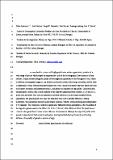Por favor, use este identificador para citar o enlazar a este item:
http://hdl.handle.net/10261/88723COMPARTIR / EXPORTAR:
 SHARE SHARE
 CORE
BASE CORE
BASE
|
|
| Visualizar otros formatos: MARC | Dublin Core | RDF | ORE | MODS | METS | DIDL | DATACITE | |

| Título: | Does the trophic habitat influence the biochemical quality of the gonad of Octopus vulgaris? Stable isotopes and lipid class contents as bio-indicators of different life-cycle strategies |
Autor: | Lourenço, Silvia; Narciso, Luis; González, Ángel F. CSIC ORCID; Pereira, Joao; Aubourg, Santiago P. CSIC ORCID; Xavier, José C. | Palabras clave: | Octopus vulgaris Trophic habitat Gonad quality Bio-indicators |
Fecha de publicación: | 2014 | Editor: | Springer Nature | Citación: | Hydrobiologia 725(1): 33-46 (2014) | Resumen: | This study aims to test whether environmental conditions including the trophic habitat and diet impact the biochemical composition of storage organs and affect the nutritional quality of eggs of Octopus vulgaris. Trophic habitat and gonad quality of neighbouring populations off the Portuguese coast, subject to different oceanographic regimes, were compared using the digestive gland and beaks as recorders of trophic and habitat preferences, and gonads as indicators of egg quality. Cholesterol, phospholipids and triacylglycerol content, essential fatty acid (EFA) profile of the digestive gland and stable isotopes, δ15N and δ13C, in the buccal mass flesh and beaks were indicators of the differences in the trophic habitat between populations. For gonad quality, the same bio-indicators were used to identify differences with maturation. The study shows that, although diet influences the EFA profile of the gonads to a certain degree, the main lipid content, phospholipids and cholesterol content in the gonads are not influenced by habitat conditions. This, therefore, suggests that O. vulgaris is able to influence the quality of egg content independent of diet. The species is believed to be an income breeder which attains maturity upon reaching a sufficient condition level, then channelling energy directly from food to gonad development. | Descripción: | 14 páginas, 3 figuras, 3 tablas | Versión del editor: | http://dx.doi.org/10.1007/s10750-013-1717-0 | URI: | http://hdl.handle.net/10261/88723 | DOI: | 10.1007/s10750-013-1717-0 | ISSN: | 0018-8158 | E-ISSN: | 1573-5117 |
| Aparece en las colecciones: | (IIM) Artículos |
Ficheros en este ítem:
| Fichero | Descripción | Tamaño | Formato | |
|---|---|---|---|---|
| Trophic_habitat_influence.pdf | 1 MB | Adobe PDF |  Visualizar/Abrir |
CORE Recommender
SCOPUSTM
Citations
6
checked on 21-abr-2024
WEB OF SCIENCETM
Citations
6
checked on 29-feb-2024
Page view(s)
344
checked on 24-abr-2024
Download(s)
421
checked on 24-abr-2024
Google ScholarTM
Check
Altmetric
Altmetric
NOTA: Los ítems de Digital.CSIC están protegidos por copyright, con todos los derechos reservados, a menos que se indique lo contrario.
